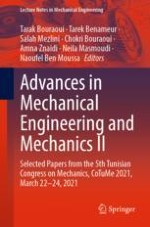This book reports on recent findings and applications relating to structure modeling and computation, design methodology, advanced manufacturing, mechanical behavior of materials, fluid mechanics, energy, and heat transfer. Further, it highlights cutting-edge issues in biomechanics and mechanobiology, and describes simulation and intelligent techniques applied to the control of industrial processes. Chapters are based on a selection of original peer-reviewed papers presented at the 5th International Tunisian Congress on Mechanics, COTUME, which was held on March 22–24, 2021, from Hammamet, Tunisia, in hybrid format. All in all, the book offers a good balance of fundamental research and industrially relevant applications, and an in-depth analysis of the current state of the art and challenges in various subfields of mechanical engineering; it provides researchers and professionals with a timely snapshot and a source of inspiration for future research and collaborations.
